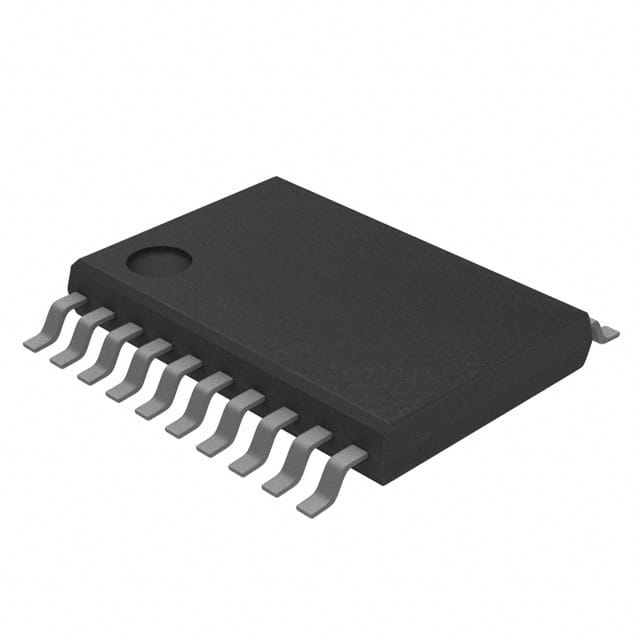SN74LV244ATPWR
Overview
- Category: Integrated Circuit (IC)
- Use: Buffer/Line Driver
- Characteristics: Low-voltage, Octal Bus Buffer with 3-State Outputs
- Package: TSSOP (Thin Shrink Small Outline Package)
- Essence: The SN74LV244ATPWR is a high-performance buffer and line driver IC designed for low-voltage applications.
- Packaging/Quantity: Tape and Reel, 2500 pieces per reel
Specifications
- Supply Voltage Range: 1.65V to 5.5V
- Input Voltage Range: 0V to VCC
- Output Voltage Range: 0V to VCC
- High-Level Input Voltage: 0.7 x VCC to VCC
- Low-Level Input Voltage: 0V to 0.3 x VCC
- High-Level Output Voltage: 0.9 x VCC to VCC
- Low-Level Output Voltage: 0V to 0.1 x VCC
- Maximum Operating Frequency: 100MHz
- Number of Channels: 8
- Output Type: 3-State
Detailed Pin Configuration
The SN74LV244ATPWR has a total of 20 pins, which are arranged as follows:
+---+--+---+
OE1 |1 +--+ 20| VCC
A1 |2 19| B1
A2 |3 18| B2
A3 |4 17| B3
A4 |5 16| B4
A5 |6 15| B5
A6 |7 14| B6
A7 |8 13| B7
GND |9 12| B8
OE2 |10 11| A8
+----------+
Functional Features
- Octal buffer and line driver with 3-state outputs.
- Designed for low-voltage applications, making it suitable for use in portable devices.
- Provides high-speed signal amplification and buffering capabilities.
- Allows bidirectional data flow and can be used as a level shifter.
- Supports hot insertion and removal of devices without causing damage.
Advantages and Disadvantages
Advantages: - Low-voltage operation allows for compatibility with various systems. - High-speed performance enables efficient data transmission. - 3-state outputs provide flexibility in controlling bus lines. - Hot insertion support simplifies device integration.
Disadvantages: - Limited number of channels (8) may not be sufficient for certain applications. - Not suitable for high-voltage applications. - Requires careful handling to prevent electrostatic discharge (ESD) damage.
Working Principles
The SN74LV244ATPWR operates by receiving input signals on its A1-A8 pins. These signals are then amplified and buffered internally before being transmitted to the corresponding B1-B8 output pins. The OE1 and OE2 pins control the enable/disable state of the outputs. When these pins are active, the outputs are enabled and can drive external circuitry. When inactive, the outputs enter a high-impedance state, allowing other devices to drive the bus lines.
Detailed Application Field Plans
The SN74LV244ATPWR is commonly used in various electronic systems that require signal buffering and level shifting. Some specific application fields include:
Microcontroller Systems: The IC can be used to interface microcontrollers with other peripheral devices, such as sensors, displays, and memory modules.
Communication Systems: It can be employed in communication equipment, such as routers, switches, and network interface cards, to amplify and buffer signals between different components.
Industrial Automation: The IC finds applications in industrial control systems, where it helps in signal conditioning, isolation, and driving various actuators and sensors.
Automotive Electronics: It can be utilized in automotive electronics for signal buffering and level shifting in systems like infotainment, powertrain control, and driver assistance.
Detailed and Complete Alternative Models
- SN74LV245A: Similar to SN74LV244ATPWR, but with bidirectional data flow capability.
- SN74LVC244A: A low-voltage version of the IC with improved performance and lower power consumption.
- SN74HCT244: A high-speed CMOS logic IC with 3-state outputs, suitable for both 5V and 3.3V systems.
These alternative models offer similar functionality and can be considered as replacements depending on specific requirements and system constraints.
In conclusion, the SN74LV244ATPWR is a versatile buffer and line driver IC designed for low-voltage applications. Its high-speed performance, 3-state outputs, and compatibility with various
Senaraikan 10 soalan dan jawapan biasa yang berkaitan dengan aplikasi SN74LV244ATPWR dalam penyelesaian teknikal
Sure! Here are 10 common questions and answers related to the application of SN74LV244ATPWR:
Q: What is SN74LV244ATPWR? A: SN74LV244ATPWR is a non-inverting octal buffer and line driver with 3-state outputs, commonly used in digital logic applications.
Q: What is the operating voltage range for SN74LV244ATPWR? A: The operating voltage range for SN74LV244ATPWR is typically between 1.65V and 5.5V.
Q: What is the maximum output current that SN74LV244ATPWR can drive? A: SN74LV244ATPWR can drive up to 12mA of output current per channel.
Q: Can SN74LV244ATPWR be used as a level shifter? A: Yes, SN74LV244ATPWR can be used as a level shifter to convert signals between different voltage levels.
Q: How many input and output channels does SN74LV244ATPWR have? A: SN74LV244ATPWR has 8 input channels and 8 output channels.
Q: What is the propagation delay of SN74LV244ATPWR? A: The propagation delay of SN74LV244ATPWR is typically around 5ns.
Q: Can SN74LV244ATPWR be used in high-speed applications? A: Yes, SN74LV244ATPWR is suitable for high-speed applications due to its low propagation delay and fast switching characteristics.
Q: Is SN74LV244ATPWR compatible with TTL logic levels? A: Yes, SN74LV244ATPWR is compatible with TTL logic levels, making it versatile for interfacing with different types of logic families.
Q: Can SN74LV244ATPWR be used in bidirectional applications? A: No, SN74LV244ATPWR is a unidirectional buffer and line driver, so it is not suitable for bidirectional applications.
Q: What is the package type for SN74LV244ATPWR? A: SN74LV244ATPWR is available in a TSSOP-20 package, which is a small surface-mount package with 20 pins.
Please note that these answers are general and may vary depending on specific datasheet specifications and application requirements.


